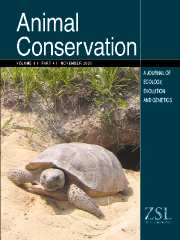Crossref Citations
This article has been cited by the following publications. This list is generated based on data provided by
Crossref.
BLAKE, STEPHEN
and
HEDGES, SIMON
2004.
Sinking the Flagship: the Case of Forest Elephants in Asia and Africa.
Conservation Biology,
Vol. 18,
Issue. 5,
p.
1191.
McShea, William J.
Koy, Kevin
Clements, Thomas
Johnson, Arlyne
Vongkhamheng, Chantavy
and
Aung, Myint
2005.
Finding a needle in the haystack: Regional analysis of suitable Eld’s deer (Cervus eldi) forest in Southeast Asia.
Biological Conservation,
Vol. 125,
Issue. 1,
p.
101.
Lynam, Antony J.
Khaing, Saw tun
and
Zaw, Khin Maung
2006.
Developing a National Tiger Action Plan for the Union of Myanmar.
Environmental Management,
Vol. 37,
Issue. 1,
p.
30.
Hedges, Simon
2006.
Biology, Medicine, and Surgery of Elephants.
p.
475.
Myint Aung, U.
2007.
Policy and practice in Myanmar's protected area system.
Journal of Environmental Management,
Vol. 84,
Issue. 2,
p.
188.
Thitaram, Chatchote
Thongtip, Nikorn
Somgird, Chaleamchart
Colenbrander, Ben
van Boxtel, Dick C. J.
van Steenbeek, Frank
and
Lenstra, Johannes A.
2008.
Evaluation and selection of microsatellite markers for an identification and parentage test of Asian elephants (Elephas maximus).
Conservation Genetics,
Vol. 9,
Issue. 4,
p.
921.
Fernando, Prithiviraj
Wikramanayake, Eric D.
Janaka, H.K.
Jayasinghe, L.K.A.
Gunawardena, Manori
Kotagama, Sarath W.
Weerakoon, Devaka
and
Pastorini, Jennifer
2008.
Ranging behavior of the Asian elephant in Sri Lanka.
Mammalian Biology,
Vol. 73,
Issue. 1,
p.
2.
Deem, Sharon L.
and
Htun, Wan
2008.
Zoo and Wild Animal Medicine.
p.
369.
Brodie, Jedediah F.
Helmy, Olga E.
Brockelman, Warren Y.
and
Maron, John L.
2009.
Bushmeat poaching reduces the seed dispersal and population growth rate of a mammal‐dispersed tree.
Ecological Applications,
Vol. 19,
Issue. 4,
p.
854.
Loucks, Colby
Mascia, Michael B.
Maxwell, Andy
Huy, Keavuth
Duong, Kong
Chea, Nareth
Long, Barney
Cox, Nick
and
Seng, Teak
2009.
Wildlife decline in Cambodia, 1953–2005: exploring the legacy of armed conflict.
Conservation Letters,
Vol. 2,
Issue. 2,
p.
82.
Rood, Ente
Ganie, Abdullah A.
and
Nijman, Vincent
2010.
Using presence‐only modelling to predict Asian elephant habitat use in a tropical forest landscape: implications for conservation.
Diversity and Distributions,
Vol. 16,
Issue. 6,
p.
975.
LYNAM, Antony J.
2010.
Securing a future for wild Indochinese tigers: Transforming tiger vacuums into tiger source sites.
Integrative Zoology,
Vol. 5,
Issue. 4,
p.
324.
Barua, Maan
2010.
Whose Issue? Representations of Human-Elephant Conflict in Indian and International Media.
Science Communication,
Vol. 32,
Issue. 1,
p.
55.
Kumar, M. Ananda
Mudappa, Divya
and
Raman, T. R. Shankar
2010.
Asian Elephant Elephas Maximus Habitat Use and Ranging in Fragmented Rainforest and Plantations in the Anamalai Hills, India.
Tropical Conservation Science,
Vol. 3,
Issue. 2,
p.
143.
Webber, C. Elizabeth
Sereivathana, Tuy
Maltby, Matthew P.
and
Lee, Phyllis C.
2011.
Elephant crop-raiding and human–elephant conflict in Cambodia: crop selection and seasonal timings of raids.
Oryx,
Vol. 45,
Issue. 2,
p.
243.
Renner, Swen C.
2011.
Bird Species-Richness Pattern in the Greater Himalayan Mountains—A General Introduction.
Ornithological Monographs,
Vol. 70,
Issue. 1,
p.
1.
Ahlering, Marissa A.
Hedges, Simon
Johnson, Arlyne
Tyson, Martin
Schuttler, Stephanie G.
and
Eggert, Lori S.
2011.
Genetic diversity, social structure, and conservation value of the elephants of the Nakai Plateau, Lao PDR, based on non-invasive sampling.
Conservation Genetics,
Vol. 12,
Issue. 2,
p.
413.
Silva, Shermin de
Ranjeewa, Ashoka D.G.
and
Weerakoon, Devaka
2011.
Demography of Asian elephants (Elephas maximus) at Uda Walawe National Park, Sri Lanka based on identified individuals.
Biological Conservation,
Vol. 144,
Issue. 5,
p.
1742.
Allendorf, Teri D.
Aung, Myint
and
Songer, Melissa
2012.
Using residents' perceptions to improve park-people relationships in Chatthin Wildlife Sanctuary, Myanmar.
Journal of Environmental Management,
Vol. 99,
Issue. ,
p.
36.
Fernando, Prithiviraj
Leimgruber, Peter
Prasad, Tharaka
Pastorini, Jennifer
and
Hayward, Matt
2012.
Problem-Elephant Translocation: Translocating the Problem and the Elephant?.
PLoS ONE,
Vol. 7,
Issue. 12,
p.
e50917.


